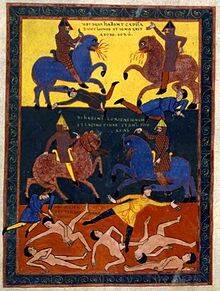I had heard many rumors about Columban Fr. Donal McIlraith’s book on the Revelation of John, Everybody’s Apocalypse: A Reflection Guide (published 1995) long before I had seen it or laid hands on it. Other Catholic biblical scholars, most of whom had studied at the Gregorian University in Rome or at the Pontifical Biblical Institute, including Fr. Scott Carl of the St. Paul Seminary, knew of the little book and spoke highly of it. There was one little problem with the book: it was difficult to find or purchase. In this day of easy access to books – when I see a novel I want on amazon.com, with one click it is on my Kindle – this was that rarity, a hard to find book!
On November 10, 2013, however, I found an e-mail in my inbox from my retired colleague Fr. David Smith, a New Testament scholar himself, saying that Fr. Donal would be celebrating Mass that night in Minneapolis. The problem was that Nov. 10 is my birthday and I could not make it to the Mass due to other plans. I e-mailed David and asked him to ask Fr. Donal how to acquire a copy of his book. I thought nothing more about it – I did not hear back one way or another – but about two weeks later, I looked in my office mailbox and there was a copy of Everybody’s Apocalypse: A Reflection Guide, with a short note from Fr. Donal.
I was excited, but did not have time to read it until now. Here is what I can tell you about the book and its origin. Fr. Donal teaches in Suva, Fiji at the Pacific Regional Seminary and also at Pacific Regional College and Corpus Christi Training College. He once taught at my university, the University of St. Thomas (five years in the 70s-80s), which is why he was in town in November celebrating Mass and visiting old friends, but has been in Fiji since 1989. There are benefits to being in Fiji, even if book distribution is not one of them, since Fr. Donal told me it was 93 F (32/33 C) on the weekend, whereas it is -11 F (-24C) today in St. Paul. (I think if John had been exiled in Minnesota and not Patmos, hell would be frozen lakes and not lakes of fire.)
The book is only 124 pages, which includes five appendices and a short bibliography. The content of the book initially appeared as articles for the Fijian Catholic newspaper Contact and then later was published in the Tongan Catholic newspaper Taumu’a Leilei. The book is a compilation of these articles and is published by the Pacific Regional Seminary (ISBN: 982-342-001-7). Fr. Donal studied the apocalypse under Fr. Ugo Vanni, SJ at the Gregorian University and at the Pontifical Biblical Institute. His doctoral thesis, supervised by Vanni, was on the Covenantal/ Nuptial reality in the Apocalypse (which itself is being revised as a book).
The book is published in Fiji and makes its way to the US and elsewhere every now and then, but it is not available broadly. Other Catholic biblical scholars have touted the book to publishers, but one major publisher felt it was too technical and would not sell. But if this little book is too technical, it is hard to see what book on the apocalypse could be published for a broad audience and what a “less technical” book on the apocalypse would look like. This book has no footnotes and carries its deep learning lightly, expressing insights into the apocalyptic genre, the Greek language, and 1st century Roman life without bogging readers down in minutiae of scholarship.
The reality is that apocalyptic language is complex, mysterious, confusing and difficult. As Fr. Donal writes, “it is good to be puzzled by the symbols. They are supposed to be puzzling. They are supposed to make us stop and think – and pray” (35). A bit later he picks up this theme, saying, “the task of understanding each symbol and seeing its relationship to the entirety of the symbols of this book is a difficult task to which the Church of each age is called. This discernment process should be carried out at various levels. Such a process would then assist the Church to evaluate the age in which it lives in the light of the Gospel” (37). If this literate guide, or others like it, are not available to people in the pews, they will find their information elsewhere, because people are attracted to John’s Revelation, and many untrustworthy sources are readily available on the internet.
Fr. Donal’s book, written for regional newspapers, is not overly technical, but it is careful and precise, in an attempt as he says “to make this puzzling part of the Scriptures more accessible to people as requested by Vatican II (Dei verbum 5)” (v). The book is accessible for readers who want to understand the Revelation of John from an expert because it covers all of the bases an expert must cover but does it without all of the scholarly apparatus which can bog non-specialists down. It has, appropriately, seven chapters, but each chapter is divided into numerous subsections based on the text of Revelation. So, for instance, Chapter One, covering the Vision of Christ in 1:4-20, has five subsections covering six pages. Each subsection has the appropriate biblical text and then comment, with two or three questions at the end for further reflection.
The text is also accompanied by (black and white) reproductions of illustrations from the Abbott Beatus’ (d. 798 A.D.) commentary on the Apocalypse. (Fr. Donal told me that “a Fijian translation is almost ready for printing and that will be in full color.”) There are also 13 “information boxes” spread throughout the short book, which deal with topics such as authorship, symbols, early Roman emperors, etc. This is a terrific way to deal with essential historical data without bogging the text down. As I said earlier, the book also has five appendices which cover symbols in more depth, ways of interpreting the apocalypse, the numeric value of ancient alphabets (gematria), the relationship of apocalyptic thought to prophetic thought, and OT references in the Apocalypse. I want to mention the OT reference appendix briefly because the Apocalypse of John does not cite the OT at all, but it is generally accepted that the text is drenched in the OT with over 800 allusions to various OT texts. Fr. Donal supplies OT allusions, based on Ugo Vanni, SJ’s work in Italian, in the hundreds, listing the possible OT allusions by chapter and verse in his appendix. What a terrific aid and guide this is for any reader, beginning or expert, for when John is read with the OT many “obscure” passages jump to life.
Fr. Donal also does a terrific job of weighing the various means of interpreting this text, not just in an appendix, but in his actual commentary. He gives proper weight to the historical dimension of John’s text, accurately interpreting it in the context of 1st century Rome, but he does not ignore the future dimension of apocalyptic thought (the whole text, as he stresses, is about the risen Lord and the return of the Lord sometime in the future) or the current dimension (Jesus is Lord now and much of the Revelation of John has liturgical context and liturgical meaning). The whole book is a sober examination, by an expert, of a fascinating book, but “sober” should not be interpreted as “boring.” Fr. Donal rescues Revelation from its wilder interpretations, or from those who would sideline it as too strange or odd, and restores it to its rightful place in the canon because of his focus on the Risen Lord at the center of his study.
I recommend this little book, and I will be writing more on the apocalypse in the weeks ahead, and encourage you to find a copy. I will even try to help you with that process. I will continue to encourage Fr. Donal to find a publisher that can distribute the book more widely – perhaps even an e-book would be a good means to get wide circulation quickly - but in the meantime he says, “as regards getting copies, I have plenty here in Fiji and am happy to ship them to people who are interested.” I have not yet asked him if I can supply you with his e-mail, but if he says yes, you will find it in an update to this post. In the meantime, he does indeed teach at Pacific Regional Seminary in Fiji!
John W. Martens
I invite you to follow me on Twitter @Biblejunkies
I encourage you to “Like” Biblejunkies on Facebook.
This entry is cross-posted at Biblejunkies









Edward,
Fr. Donal's book is anything but "skeptical," whatever you might mean by that, but is a fine study of Revelation within the context of the Church's teaching. I am not certain what gave you the idea that his book is part of a "generally skeptical perspective that runs through contemporary Catholic biblical scholarship" or purveys a "sense of critical disbelief in the object of their study" or whether you believe this about biblical scholarship in general or this book in particular. (I could not tell from your comment, that is, whether you feel Fr. Donal's book is indicative of skepticism about the Bible or whether you feel his book stands outside of this strain of thought, but suffers from being lumped in with such books.) "NT Wright's "Revelation for Everyone" and Scott Hahn's "The Lamb's Supper" are both good books," but I like Fr. Donal's better as an introduction to the Revelation of John. You should read it.
John